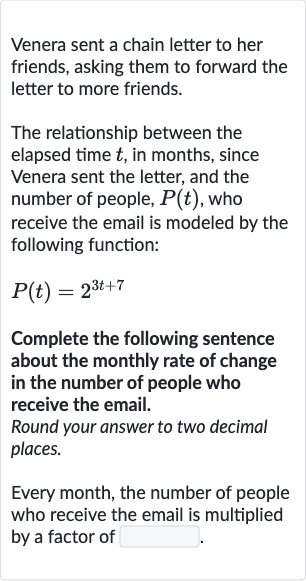AI tutor
Welcome to Bytelearn!
Let’s check out your problem:

Venera sent a chain letter to her friends, asking them to forward the letter to more friends.The relationship between the elapsed time , in months, since Venera sent the letter, and the number of people, , who receive the email is modeled by the following function:Complete the following sentence about the monthly rate of change in the number of people who receive the email.Round your answer to two decimal places.Every month, the number of people who receive the email is multiplied by a factor of
Full solution
Q. Venera sent a chain letter to her friends, asking them to forward the letter to more friends.The relationship between the elapsed time , in months, since Venera sent the letter, and the number of people, , who receive the email is modeled by the following function:Complete the following sentence about the monthly rate of change in the number of people who receive the email.Round your answer to two decimal places.Every month, the number of people who receive the email is multiplied by a factor of
- Understanding Rate of Change: To find the monthly rate of change, we need to understand how the function changes as increases by , which represents one month. We will compare with .
- Calculating P(t): First, let's calculate P(t) for an arbitrary month :
- Calculating P(t+): Now, let's calculate for the next month:
- Finding the Monthly Factor: To find the factor by which the number of people is multiplied each month, we divide by :Factor =
- Simplifying the Expression: Using the properties of exponents, we can simplify the expression by subtracting the exponents:Factor =
- The Monthly Multiplication Factor: The factor by which the number of people who receive the email is multiplied every month is . This means that every month, the number of people who receive the email is multiplied by a factor of .
More problems from Compound interest: word problems
QuestionGet tutor help
QuestionGet tutor help
QuestionGet tutor help
QuestionGet tutor help
QuestionGet tutor help
QuestionGet tutor help
QuestionGet tutor help
QuestionGet tutor help
QuestionGet tutor help
